Access Forms
How to Create Dynamic Microsoft Access Forms
Table of Contents
Background Color
Consistent Font Use
Logical Groupings and Alignment
Clear navigation
User-centric instead of Data-centric
Deemphasizing non-critical information
Inline calculations
Form window behaviors
Summary and Detail Forms
Load forms with context
Whether you are starting a new database, or renovating an old one, Access
Form Design is one of the most entertaining and also important steps.
Do it right, and you have a highly functional, productive application
with a professional look and feel to hand to your users.
In the course of daily business, we see a lot of our customers Microsoft Access forms. Some are great, and some are stuck in 1998 design paradigms. This article gives you ideas for key ways to improve your MS Access forms in a few minutes.
In the course of daily business, we see a lot of our customers Microsoft Access forms. Some are great, and some are stuck in 1998 design paradigms. This article gives you ideas for key ways to improve your MS Access forms in a few minutes.
10 Ways to Improve your Access Forms without using Visual Basic
| 1 |
Background ColorAccess 2003 and previous versions use a dark gray as the default background color for forms. While this was the norm in 1995, nowadays it's a sign that an application is stale. The fix is easy! Open your form in Design View, select the detail background, and change the color in the toolbar/ribbon. This, by far, is the easiest and fastest way to give your forms a new look.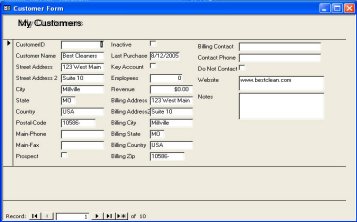 Aging gray  Modern white |
| 2 |
Consistent font useThe visual appeal of your forms is largely determined by how fast your viewer can mentally process the information. Surprisingly, little things like font size, font type (family), and what is bold or underlined can make a huge difference. Specialists in the Human Factors discipline sometimes call this cognitive dissonance. How many distractions does your brain need to ignore before it can start really understanding what is important. If everything is bold, underlined, or displayed in different fonts, sizes, and colors, your users will become overwhelmed. It will take longer for them to understand where to start, what is important, and what can they ignore.Font Weight and Underline If every label and field is bold on your form (and we've seen a lot of this), it can convey the message to your user that your form is screaming at them. If every label is underlined, it also loses the desired effect. From a young age, our brains learn that important things are bold and/or underlined. So we recommend making sure your forms have very little bolding, and even less underlining. Font Family Access 2000 through 2003 used a mixture of Tahoma and MS Sans Serif fonts in forms and reports. Access 2007 started using Calibri, a more generous font used in most Office 2007 applications. Select all the labels and controls on your form with your mouse in Design View, and change them to one font. It doesn't matter which you choose (Arial, Verdana, Calibri are usually preferred for on-screen display). Font Size It's obvious to state, but anything larger on screen will demand your users attention (for better or worse). So use sizing sparingly. Unless your audience is visually challenged (age, sight), a font size of 10pt is usually adequate for all entry fields and labels. 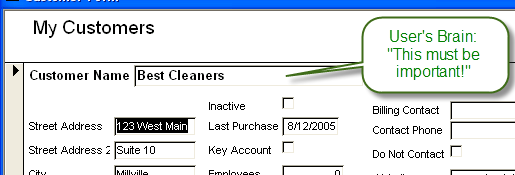 Required Fields In many cases, you have one or more required fields on your forms you want to require input for. You have the table or form validation rules set to require input. What's more frustrating for a user than getting those error messages after you think you've filled everything out right? There are two ways you can visually indicate to the user that a field is required: 1) Make required field labels bold. This works best when you don't plan to use bold for other purposes. 2) Add a red asterisk label next to the label of required fields. 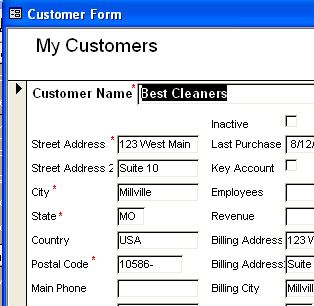 |
| 3 |
Logical Groupings and AlignmentThe next important step is to make sure your form fields are grouped in a logical fashion, and aligned to a common grid. Fortunately Access provides easy tools for both.Grouping Grouping fields accomplishes two key things. First, your user will know where related information is on your form. Second, you can begin to draw the line between key data you need from the user or the user needs to see, and information that is less important. The two major tools you can use are the Option Group Box or the Rectangle. If you add an Option Group box to your form, it will ask you what options you want to display to the user. Click cancel, and you'll have the option frame on your form without any radio buttons.  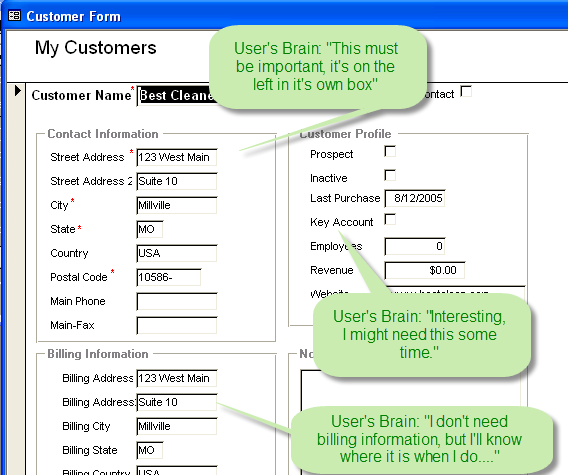 Alignment When a form on the web, in Access, or even at the doctor's office has some boxes that are slightly off alignment, we know. For some people, it's a chuckle, for others, it's cause for real irritation and distraction. Gladly, Access has several tools to make this easy. In Access 2000, 2002, and 2003, they are in the toolbar: 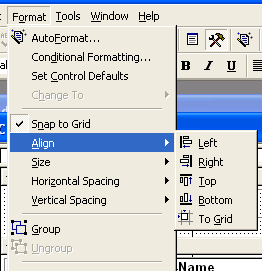
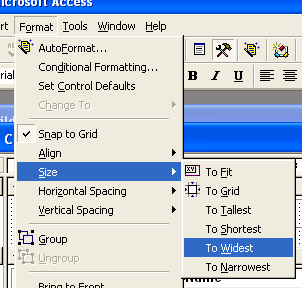 In Access 2007 and 2010, the Ribbon has made them more easily accessible:  Select the controls you want to align or make a consistent size, and use the tools shown above to make them consistently aligned and/or sized. For sizing, you can do a great deal to save space on your forms while also making them look cleaner: 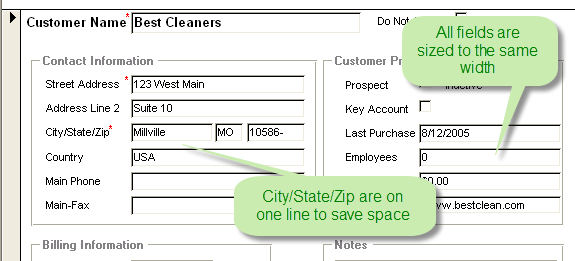 |
| 4 |
Clear navigationClear navigation is important to any user. Navigation gives the user context of where they are, and what they can do in your application. There are several ways to provide for this need: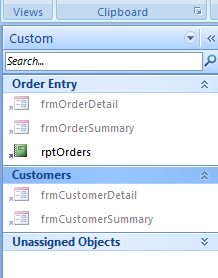 Custom Groups in Access 2007 Access 2000/2002/2003 offers the Database Window for basic navigation. In Access 2007/2010 the Navigation Pane provides a persistent navigation pane to move between objects. Both are fine for developers and power users, but less adequate for casual users or when you want to make sure your users aren't getting themselves into trouble "exploring" your Access database. The best you can do with these is to create a favorite group (2000-2003) or custom group (2007+) to help users identify key forms they need to use. Access Switchboard Manager Fortunately, Access includes a built-in menu system, the Access Switchboard Manager. It allows you to create an unlimited hierarchy of menus and sub-switchboards. You can specify what each Access Switchboard menu button can do (limited to about 8 options). The Access Switchboard is quick and easy to put in place. That's the good. The downsides are an antiquated 1995 look, and any customizations apply to every page (unless you get in to the internal VB workings) of your switchboard. 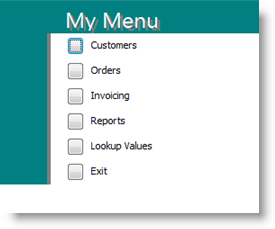 Access Switchboard Manager Custom Navigation Menu You can always create your own navigation menu form. All you need to do is create a new blank form that isn't bound to a table (an unbound form) add buttons, and then macros or VB code for each button to launch your forms. Often a fun way to make your application have it's own character. 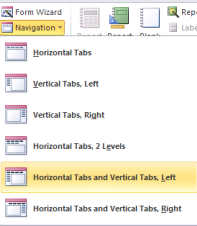 Access 2010 Navigation form types Access 2010 Navigation Forms Access 2010 introduced a new navigation form type accessible via the Create Ribbon tab. The navigation form allows you to drop in a form to display within the menu area. Unlike the Switchboard Manager, the Navigation forms are not readily configurable. You can easily change them at design time, but unlike the Switchboard Manager, they are managed in the Design View instead of via a configuration menu. UI Builder OpenGate's UI Builder tool is another popular way to add menu navigation to your databases. UI Builder is configurable, provides more pre-built menu commands than the Access Switchboard supports submenu buttons, user level menus, and pre-packaged features. To avoid sounding like an advertisement, we'll just point you to the product page and product demo video where you can learn more. |